European Union
| | ||||
|---|---|---|---|---|
| ||||
| Motto: United in diversity[1][2][3] | ||||
Anthem: Ode to Joy
| ||||
| Political centres | Brussels
Luxembourg Strasbourg | |||
| Official languages | ||||
| Demonym | European[4] | |||
| Member States | ||||
| Leaders | ||||
| - | European Council | Herman Van Rompuy | ||
| - | Commission | José Manuel Barroso | ||
| - | Parliament | Jerzy Buzek | ||
| - | Council of Ministers | Hungary | ||
| Establishment | ||||
| - | Paris Treaty | 23 July 1952 | ||
| - | Rome Treaty | 1 January 1958 | ||
| - | Maastricht Treaty | 1 November 1993 | ||
| - | Lisbon Treaty | 1 December 2009 | ||
| Area | ||||
| - | Total | 4,324,782 km2
1,669,807 sq mi | ||
| - | Water (%) | 3.08 | ||
| Population | ||||
| - | 2010 estimate | 501,064,211[5] | ||
| - | Density | 115.9/km2
300.1/sq mi | ||
| GDP (PPP) | 2009 (IMF) estimate | |||
| - | Total | $14.793 trillion | ||
| - | Per capita | $29,729 | ||
| GDP (nominal) | 2009 (IMF) estimate | |||
| - | Total | $16.447 trillion | ||
| - | Per capita | $33,052 | ||
| Gini (2009) | 30.7 (EU25)[6] (High) | |||
| HDI (2007) | 0.937 (High) | |||
| Currency | ||||
| Time zone | (UTC+0 to +2) | |||
| - | Summer (DST) | (UTC+1 to +3[nb 1]) | ||
| Internet TLD | .eu[nb 2] | |||
| Website
europa.eu | ||||
| Calling code | See list | |||
The European Union (EU) is an economic and political union of 27 member states which are located primarily in Europe.[7] The EU traces its origins from the European Coal and Steel Community (ECSC) and the European Economic Community (EEC) formed by six countries in the 1950s. In the intervening years the EU has grown in size by the accession of new member states, and in power by the addition of policy areas to its remit. The Maastricht Treaty[8] The last amendment to the constitutional basis of the EU, the Treaty of Lisbon, came into force in 2009. established the European Union under its current name in 1993.
The EU operates through a hybrid system of supranational independent institutions and intergovernmentally made decisions negotiated by the member states.[9][10][11] Important institutions of the EU include the European Commission, the Council of the European Union, the European Council, the Court of Justice of the European Union, and the European Central Bank. The European Parliament is elected every five years by EU citizens.
The EU has developed a single market through a standardised system of laws which apply in all member states including the abolition of passport controls within the Schengen area.[12] It ensures the free movement of people, goods, services, and capital,[13] enacts legislation in justice and home affairs, and maintains common policies on trade,[14] agriculture,[15] fisheries and regional development.[16] A monetary union, the eurozone, was established in 1999 and is currently composed of seventeen member states. Through the Common Foreign and Security Policy the EU has developed a limited role in external relations and defence. Permanent diplomatic missions have been established around the world and the EU is represented at the United Nations, the WTO, the G8 and the G-20.
With a combined population of 500 million inhabitants,[17]the EU generated an estimated 21% in 2010 in ppp of the world economy, GDP is $14.793 trillion .[18],the EU generated an estimated 28% (US$ $16.106 trillion nominal) [19]( share of the global economy in 2010), the EU is also the largest exporter and importer.
Contents[hide] |
History
Outline
1945–1958
After World War II, moves towards European integration were seen by many as an escape from the extreme forms of nationalism which had devastated the continent.[20] One such attempt to unite Europeans was the European Coal and Steel Community which, while having the modest aim of centralised control of the previously national coal and steel industries of its member states, was declared to be "a first step in the federation of Europe".[21] The founding members of the Community were Belgium, France, Italy, Luxembourg, the Netherlands, and West Germany. The originators and supporters of the Community include Jean Monnet, Robert Schuman, Paul Henri Spaak, and Alcide De Gasperi.[22]
In 1957, the six countries signed the Treaties of Rome, which extended the earlier cooperation within the European Coal and Steel Community (ECSC) and created the European Economic Community, (EEC) establishing a customs union and the European Atomic Energy Communitynuclear energy. The treaty came into force in 1958.[22] (Euratom) for cooperation in developing
1958–1972

The two new communities were created separately from ECSC, although they shared the same courts and the Common Assembly. The executives of the new communities were called Commissions, as opposed to the "High Authority". The EEC was headed by Walter HallsteinHallstein Commission) and Euratom was headed by Louis Armand (Armand Commission) and then Etienne Hirsch. Euratom would integrate sectors in nuclear energy while the EEC would develop a customs union between members.[23][24][25] (
Throughout the 1960s tensions began to show with France seeking to limit supranational power. However, in 1965 an agreement was reached and hence in 1967 the Merger Treaty was signed in Brussels. It came into force on 1 July 1967 and created a single set of institutions for the three communities, which were collectively referred to as the European Communities (EC), although commonly just as the European Community.[26][27] Jean Rey presided over the first merged Commission (Rey Commission).[28]
1973–1993

In 1973 the Communities enlarged to include Denmark (including Greenland which later left the Community in 1985), Ireland, and the United Kingdom.[29] Norway had negotiated to join at the same time but Norwegian voters rejected membership in a referendum and so Norway remained outside. In 1979, the first direct, democratic elections to the European Parliament were held.[30]
Greece joined in 1981, and Spain with Portugal in 1986.[31] In 1985, the Schengen Agreementpassport controls between most member states and some non-member states.[32] In 1986, the European flag began to be used by the Community[33] and the Single European Act was signed. led the way toward the creation of open borders without
In 1990, after the fall of the Iron Curtain, the former East Germany became part of the Community as part of a newly united Germany.[34] With enlargement towards Eastern and Central Europe on the agenda, the Copenhagen criteria for candidate members to join the European Union were agreed.
1993–present

The European Union was formally established when the Maastricht Treaty came into force on 1 November 1993,[8] and in 1995 Austria, Sweden, and Finland joined the newly established EU. In 2002, euro notes and coins replaced national currencies in 12 of the member states. Since then, the eurozone has increased to encompass seventeen countries. In 2004, the EU saw its biggest enlargement to date when Malta, Cyprus, Slovenia, Estonia, Latvia, Lithuania, Poland, the Czech Republic, Slovakia, and Hungary joined the Union.[35]
On 1 January 2007, Romania and Bulgaria became the EU's newest members. In the same year Slovenia adopted the euro,[35] followed in 2008 by Cyprus and Malta, by Slovakia in 2009 and by Estonia in 2011. In June 2009, the 2009 Parliament elections were held leading to a renewal of Barroso's Commission Presidency, and in July 2009 Iceland formally applied for EU membership.
On 1 December 2009, the Lisbon Treaty entered into force and reformed many aspects of the EU. In particular it changed the legal structure of the European Union, merging the EU three pillars system into a single legal entity provisioned with legal personality, and it created a permanent President of the European Council, the first of which is Herman Van Rompuy, and a strengthened High Representative, Catherine Ashton.[36]
Treaties
| Signed
In force Document | 1948
1948 Brussels Treaty | 1951
1952 Paris Treaty | 1954
1955 Modified Brussels Treaty | 1957
1958 Rome Treaties | 1965
1967 Merger Treaty | 1975
N/A European Council conclusion | 1985
1985 Schengen Treaty | 1986
1987 Single European Act | 1992
1993 Maastricht Treaty | 1997
1999 Amsterdam Treaty | 2001
2003 Nice Treaty | 2007
2009 Lisbon Treaty | ||||||||||
| Three pillars of the European Union: | ||||||||||||||||||||||
| European Communities: | ||||||||||||||||||||||
|
| European Atomic Energy Community (EURATOM) |
|
|
|
|
|
|
|
|
| ||||||||||||
|
| European Coal and Steel Community (ECSC) | Treaty expired in 2002 |
| European Union (EU) |
|
|
|
|
|
|
|
| ||||||||||
|
| European Economic Community (EEC) |
|
| |||||||||||||||||||
| Schengen Area | European Community (EC) | |||||||||||||||||||||
| TREVI | Justice and Home Affairs (JHA) | |||||||||||||||||||||
| Police and Judicial Co-operation in Criminal Matters (PJCC) | ||||||||||||||||||||||
| European Political Cooperation (EPC) | Common Foreign and Security Policy (CFSP) | |||||||||||||||||||||
| Unconsolidated bodies | Western European Union (WEU) | |||||||||||||||||||||
| Treaty terminated in 2010 |
|
|
|
|
|
|
|
| ||||||||||||||
Geography

The territory of the EU consists of the combined territories of its 27 member states with some exceptions, outlined below. The territory of the EU is not the same as that of Europe, as parts of the continent are outside the EU. Some parts of member states are not part of the EU, despite forming part of the European continent (for example the Isle of Man and Channel Islands (three Crown Dependencies), and the Faroe Islands (a territory of Denmark)). The island country of Cyprus, a member of the EU, is closer to Turkey than to continental Europe and is often considered part of Asia.[37][38] Several territories associated with member states that are outside geographic Europe are also not part of the EU (such as Greenland and Aruba). Some overseas territories are part of the EU even though geographically not part of Europe, such as the Azores, French Guiana, Martinique and Melilla. As well, although being technically part of the EU,[39] EU law is suspended in Northern Cyprus as it is under the de facto control of the Turkish Republic of North Cyprus, a self-proclaimed state that is recognised only by Turkey.
The EU's member states cover an area of 4,422,773 square kilometres (1,707,642 sq mi).[nb 3]six countries, and its highest peak is Mont Blanc in the Graian Alps, 4,810.45 metres (15,782 ft) above sea level.[40] The lowest point in the EU is Zuidplaspolder in the Netherlands, at −7 m (−23 ft) below sea level. The landscape, climate, and economy of the EU are influenced by its coastline, which is 65,993 kilometres (41,006 mi) long. The EU has the world's second-longest coastline, after Canada. The combined member states share land borders with 19 non-member states for a total of 12,441 kilometres (7,730 mi), the fifth-longest border in the world.[10][41][42] The EU is larger in area than all but
Including the overseas territories of member states, the EU experiences most types of climateArctic to sub-tropical, rendering meteorological averages for the EU as a whole meaningless. The majority of the people lives in areas with a Mediterranean climate (Southern Europe), a temperate maritime climate (Western Europe), or a warm summer continental or hemiboreal climate (Eastern Europe).[43] from
The EU's population is highly urbanised, with some 75% of inhabitants (and growing, projected to be 90% in 7 states by 2020) living in urban areas. Cities are largely spread out across the EU, although with a large grouping in and around the Benelux. An increasing percentage of this is due to low density urban sprawl which is extending into natural areas. In some cases this urban growth has been due to the influx of EU funds into a region.[44]
Member states
| & Herz. |
The European Union is composed of 27 sovereign Member States: Austria, Belgium, Bulgaria, Cyprus, the Czech Republic, Denmark, Estonia, Finland, France, Germany, Greece, Hungary, Italy, Latvia, Lithuania, Luxembourg, Malta, the Netherlands, Poland, Portugal, Republic of Ireland, Romania, Slovakia, Slovenia, Spain, Sweden, and the United Kingdom.[45] The Union's membership has grown from the original six founding states—Belgium, France, (then-West) Germany, Italy, Luxembourg and the Netherlands—to the present day 27 by successive enlargements as countries acceded to the treaties[46] To join the EU a country must meet the Copenhagen criteria, defined at the 1993 Copenhagen European Council. These require a stable democracy that respects human rightsrule of law; a functioning market economy capable of competition within the EU; and the acceptance of the obligations of membership, including EU law. Evaluation of a country's fulfilment of the criteria is the responsibility of the European Council.[47] No member state has ever left the Union, although Greenland (an autonomous province of Denmark) withdrew in 1985.[48] The Lisbon Treaty now provides a clause dealing with how a member leaves the EU.[49] and by doing so, pooled their sovereignty in exchange for representation in the institutions. and the
There are five official candidate countries, Croatia, Iceland, Macedonia,[nb 4][50] MontenegroTurkey. Albania, Bosnia and Herzegovina and Serbia are officially recognised as potential candidates.[51] Kosovo is also listed as a potential candidate but the European Commission does not list it as an independent country because not all member states recognise it as an independent country separate from Serbia.[52] and
Four Western European countries that are not EU members have partly committed to the EU's economy and regulations: Iceland (a candidate country for EU membership), Liechtenstein and Norway, which are a part of the single market through the European Economic Area, and Switzerland, which has similar ties through bilateral treaties.[53][54] The relationships of the European microstates, Andorra, Monaco, San Marino and the Vatican include the use of the euro and other areas of cooperation.[55]
Environment
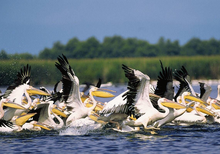
The first environmental policy of the European Community was launched in 1972. Since then it has addressed issues such as acid rain, the thinning of the ozone layer, air quality, noise pollution, waste and water pollution. The Water Framework Directive is an example of a water policy, aiming for rivers, lakes, ground and coastal waters to be of "good quality" by 2015. Wildlife is protected through the Natura 2000 programme and covers 30,000 sites throughout Europe.[56]Rospuda valley, but the Commission has been blocking construction as the valley is a wildlife area covered by the programme.[57] In 2007, the Polish government sought to build a motorway through the
In 2007, member states agreed that the EU is to use 20% renewable energy in the future and that it has to reduce carbon dioxide emissions in 2020 by at least 20% compared to 1990 levels.[58] This includes measures that in 2020, 10% of the overall fuel quantity used by cars and trucks in EU 27 should be running on renewable energy such as biofuels. This is considered to be one of the most ambitious moves of an important industrialised region to fight global warming.[59]
Politics
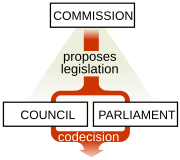
The EU operates solely within those competencies conferred on it upon the treaties and according to the principle of subsidiarity (which dictates that action by the EU should only be taken where an objective cannot be sufficiently achieved by the member states alone). Laws made by the EU institutions are passed in a variety of forms, generally speaking they can be classified into two groups: those which come into force without the necessity for national implementation measures, and those which specifically require national implementation measures.[60]
Governance
The European Union has seven institutions: the European Parliament, the Council of the European Union, the European Commission, the European Council, the European Central Bank, the Court of Justice of the European Union and the European Court of Auditors. Competencies in scrutinising and amending legislation are divided between the European Parliament and the Council of the European Union while executive tasks are carried out by the European Commission and in a limited capacity by the European Council (not to be confused with the aforementioned Council of the European Union). The monetary policy of the eurozone is governed by the European Central Bank. The interpretation and the application of EU law and the treaties are ensured by the Court of Justice of the European Union. There are also a number of ancillary bodies which advise the EU or operate in a specific area.
European Council
The European Council gives direction to the EU, and convenes at least four times a year. It comprises the President of the European Council, the President of the European Commission and one representative per member state; either its head of state or head of government. The European Council has been described by some as the Union's "supreme political authority".[61] It is actively involved in the negotiation of the treaty changes and defines the EU's policy agenda and strategies.
The European Council uses its leadership role to sort out disputes between member states and the institutions, and to resolve political crises and disagreements over controversial issues and policies. It acts externally as a "collective Head of State" and ratifies important documents (e.g. international agreements and treaties).[62]
On 19 November 2009, Herman Van Rompuy was chosen as the first permanent President of the European Council. On 1 December 2009, the Treaty of Lisbon entered into force and he assumed office. Ensuring the external representation of the EU,[63] driving consensus and settling divergences among members are tasks for the President both during the convocations of the European Council and in the time periods between them. The European Council should not be mistaken for the Council of Europe, an international organisation independent from the EU.
Commission
The European Commission acts as the EU's executive arm and is responsible for initiating legislation and the day-to-day running of the EU. The commission is also seen as the motor of European integration. The Commission operates as a cabinet government, with 27 Commissioners for different areas of policy, one from each member state, though Commissioners are bound to represent the interests of the EU as a whole rather than their home state.
One of the 27 is the Commission President (currently José Manuel Durão Barroso) appointed by the European Council. The other 26 Commissioners are subsequently appointed by the Council of the European Union in agreement with the nominated President, and then the 27 Commissioners as a single body are subject to a vote of approval by the European Parliament. After the President, the most prominent Commissioner is the High Representative of the Union for Foreign Affairs and Security Policy who is ex-officio Vice President of the Commission.[64]
Parliament

The European Parliament (EP) forms one half of the EU's legislature (the other half is the Council of the European Union, see below). The 736 (soon to be 751) Members of the European Parliament (MEPs) are directly elected by EU citizens every five years on the basis of proportional representation to the share of votes collected by each political party. Although MEPs are elected on a national basis, they sit according to political groups rather than their nationality. Each country has a set number of seats and is divided into sub-national constituencies where this does not affect the proportional nature of the voting system.[65]
The Parliament and the Council of the European Union pass legislation jointly in nearly all areas under the ordinary legislative procedure. This also applies to the EU budget. Finally, the Commission is accountable to Parliament, requiring its approval to take office, having to report back to it and subject to motions of censure from it. The President of the European Parliamentspeaker in parliament and represents it externally. The EP President and Vice Presidents are elected by MEPs every two and a half years.[66] carries out the role of
Council
The Council of the European Union (also called the "Council"[67] and sometimes referred to as the "Council of Ministers"[68]) forms the other half of the EU's legislature. It consists of a government minister from each member state and meets in different compositions depending on the policy area being addressed. Notwithstanding its different compositions, it is considered to be one single body.[69] In addition to its legislative functions, the Council also exercises executive functions in relations to the Common Foreign and Security Policy.
Budget
 |
| The total expenditure of the European Union in 2006.[70] |
The twenty-seven member state EU had an agreed budget of €120.7 billion for the year 2007 and €864.3 billion for the period 2007–2013,[71] representing 1.10% and 1.05% of the EU-27's GNI forecast for the respective periods. By comparison, the United Kingdom's expenditure for 2004 was estimated to be €759 billion, and France was estimated to have spent €801 billion. In 1960, the budget of the then European Economic Community was 0.03% of GDP.[72]
In the 2010 budget of €141.5 billion, the largest single expenditure item is cohesion & competitiveness with around 45% of the total budget.[73] Next comes agriculture with approximately 31% of the total.[73] Rural development, environment and fisheries takes up around 11%.[73] Administration accounts for around 6%.[73] The EU as a global partner and citizenship, freedom, security and justice bring up the rear with approximately 6% and 1% respectively.[73]
The EU fifth institution, the European Court of Auditors ensures that the budget of the European Union has been properly accounted for. The court provides an audit report for each financial year to the Council and Parliament. The Parliament uses this to decide whether to approve the Commission's handling of the budget. The Court also gives opinions and proposals on financial legislation and anti-fraud actions.[74]
The Court of Auditors is legally obliged to provide the European European Parliament and the Council with "a statement of assurance as to the reliability of the accounts and the legality and regularity of the underlying transactions".[75] The Court has not given an unqualified approval of the Union's accounts since 1993.[76] In their report on 2009 the auditors found that five areas of Union expenditure, agriculture and the cohesion fund, were materially affected by error.[77][78] The EC estimated that the financial impact of irregularities was €1,863 million.
Competences
EU member states retain all powers not explicitly handed to the Union. In some areas the EU enjoys exclusive competence. These are areas in which member states have renounced any capacity to enact legislation. In other areas the EU and its member states share the competence to legislate. While both can legislate, member states can only legislate to the extent to which the EU has not. In other policy areas the EU can only co-ordinate, support and supplement member state action but cannot enact legislation with the aim of harmonising national laws.[79]
That a particular policy area falls into a certain category of competence is not necessarily indicative of what legislative procedure is used for enacting legislation within that policy area. Different legislative procedures are used within the same category of competence, and even with the same policy area.
The distribution of competences in various policy areas between Member States and the Union is divided in the following three categories:
| As outlined in Part I, Title I of the consolidated Treaty on the Functioning of the European Union: | ||||||||||||||||
|
|
| ||||||||||||||
Legal system
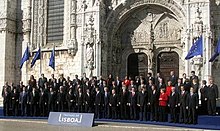

The EU is based on a series of treaties. These first established the European Community and the EU, and then made amendments to those founding treaties.[80] These are power-giving treaties which set broad policy goals and establish institutions with the necessary legal powers to implement those goals. These legal powers include the ability to enact legislation[nb 5] which can directly affect all member states and their inhabitants.[nb 6] The EU has legal personality, with the right to sign agreements and international treaties.[81]
Under the principle of supremacy, national courts are required to enforce the treaties that their member states have ratified, and thus the laws enacted under them, even if doing so requires them to ignore conflicting national law, and (within limits) even constitutional provisions.[nb 7]
Courts of Justice
The judicial branch of the EU—formally called the Court of Justice of the European Union—consists of three courts: the Court of Justice, the General Court, and the European Union Civil Service Tribunal. Together they interpret and apply the treaties and the law of the EU.[82]
The Court of Justice primarily deals with cases taken by member states, the institutions, and cases referred to it by the courts of member states.[83] The General Court mainly deals with cases taken by individuals and companies directly before the EU's courts,[84] and the European Union Civil Service Tribunal adjudicates in disputes between the European Union and its civil service.[85] Decisions from the General Court can be appealed to the Court of Justice but only on a point of law.[86]
Fundamental rights

"Human dignity is inviolable. It must be respected and protected.
Everyone has the right to life. No one shall be condemned to death penalty, or executed."
The treaties declare that the EU itself is "founded on the values of respect for human dignity, freedom, democracy, equality, the rule of law and respect for human rights, including the rights of persons belonging to minorities ... in a society in which pluralism, non-discrimination, tolerance, justice, solidarity and equality between women and men prevail."[87]
In 2009 the Lisbon Treaty gave legal effect to the Charter of Fundamental Rights of the European Union. The charter is a codified catalogue of fundamental rights against which the EU's legal acts can be judged. It consolidates many rights which were previously recognised by the European Court of Justice and derived from the "constitutional traditions common to the member states."[88] The European Court of Justice has long recognised fundamental rights and has, on occasion, invalidated EU legislation based on its failure to adhere to those fundamental rights.[89] The Charter of Fundamental Rights was drawn up in 2000. Although originally not legally binding the Charter was frequently cited by the EU's courts as encapsulating rights which the courts had long recognised as the fundamental principles of EU law.

Although signing the European Convention on Human Rights (ECHR) is a condition for EU membership,[nb 8] previously, the EU itself could not accede to the Convention as it is neither a state[nb 9] nor had the competence to accede.[nb 10] The Lisbon Treaty and Protocol 14 to the ECHR have changed this: the latter binds the EU to accede to the Convention while the former formally permits it.
The EU also promoted human rights issues in the wider world. The EU opposes the death penalty and has proposed its world wide abolition.[90] Abolition of the death penalty is a condition for EU membership.[91]
Acts
The main legal acts of the EU come in three forms: regulations, directives, and decisions. Regulations become law in all member states the moment they come into force, without the requirement for any implementing measures,[nb 11] and automatically override conflicting domestic provisions.[nb 5] Directives require member states to achieve a certain result while leaving them discretion as to how to achieve the result. The details of how they are to be implemented are left to member states.[nb 12] When the time limit for implementing directives passes, they may, under certain conditions, have direct effect in national law against member states.
Decisions offer an alternative to the two above modes of legislation. They are legal acts which only apply to specified individuals, companies or a particular member state. They are most often used in Competition Law, or on rulings on State Aid, but are also frequently used for procedural or administrative matters within the institutions. Regulations, directives, and decisions are of equal legal value and apply without any formal hierarchy.[92]
Justice and home affairs

Since the creation of the EU in 1993, it has developed its competencies in the area of justice and home affairs, initially at an intergovernmental level and later by supranationalism. To this end, agencies have been established that co-ordinate associated actions: Europol for co-operation of police forces,[93] Eurojust for co-operation between prosecutors,[94] and Frontex for co-operation between border control authorities.[95] The EU also operates the Schengen Information System[12] which provides a common database for police and immigration authorities. This cooperation had to particularly be developed with the advent of open borders through the Schengen Agreement and the associated cross border crime.
Furthermore, the Union has legislated in areas such as extradition,[96] family law,[97] asylum law,[98] and criminal justice.[99] Prohibitions against sexual and nationality discrimination have a long standing in the treaties.[nb 13] In more recent years, these have been supplemented by powers to legislate against discrimination based on race, religion, disability, age, and sexual orientation.[nb 14] By virtue of these powers, the EU has enacted legislation on sexual discrimination in the work-place, age discrimination, and racial discrimination.[nb 15]
Foreign relations
Foreign policy cooperation between member states dates from the establishment of the Community in 1957, when member states negotiated as a bloc in international trade negotiations under the Common Commercial Policy.[100] Steps for a more wide ranging coordination in foreign relations began in 1970 with the establishment of European Political Cooperation which created an informal consultation process between member states with the aim of forming common foreign policies. It was not, however, until 1987 when European Political Cooperation was introduced on a formal basis by the Single European Act. EPC was renamed as the Common Foreign and Security Policy (CFSP) by the Maastricht Treaty.[101]
The aims of the CFSP are to promote both the EU's own interests and those of the international community as a whole, including the furtherance of international co-operation, respect for human rights, democracy, and the rule of law.[102] The CFSP requires unanimity among the member states on the appropriate policy to follow on any particular issue. The unanimity and difficult issues treated under the CFSP makes disagreements, such as those which occurred over the war in Iraq,[103] not uncommon.
The co-ordinator and representative of the CFSP within the EU is the High Representative of the Union for Foreign Affairs and Security PolicyCatherine Ashton) who speaks on behalf of the EU in foreign policy and defence matters, and has the task of articulating the positions expressed by the member states on these fields of policy into a common alignment. The High Representative heads up the European External Action Service (EEAS), a unique EU department[104] that has been officially implemented and operational since 1 December 2010 on the occasion of the first anniversary of the entry into force of the Treaty of Lisbon.[105] The EEAS will serve as a foreign ministry and diplomatic corps for the European Union.[106] (currently
Besides the emerging international policy of the European Union, the international influence of the EU is also felt through enlargement. The perceived benefits of becoming a member of the EU act as an incentive for both political and economic reform in states wishing to fulfil the EU's accession criteria, and are considered an important factor contributing to the reform of former Communist countries in Central and Eastern Europe.[107] This influence on the internal affairs of other countries is generally referred to as "soft power", as opposed to military "hard power".[108]
Military

The European Union does not have one unified military. The predecessors of the European Union were not devised as a strong military alliance because NATO was largely seen as appropriate and sufficient for defence purposes.[109] Twenty-one EU members are members of NATO[110] while the remaining member states follow policies of neutrality.[111] However the compatibility of their neutrality with EU membership is questioned (including by the Prime Minister of Finland)[112] and with mutual solidarity in the event of disasters, terrorist attacks and armed aggression covered by TEU Article 42 (7) and TFEU Article 222 of the EU treaties; the Western European Union, a military alliance with a mutual defence clause, was disbanded in 2010 as its role had been transferred to the EU.[113]
According to the Stockholm International Peace Research Institute (SIPRI), the United Kingdom spent more than €48 billion (US$69 billion) on defence in 2009, placing it third in the world after USA and China, while France spent €47 billion (US$67.31 billion), the fourth largest. Together, the United Kingdom and France account for 45 per cent of Europe's defence budget, 50 per cent of its military capacity and 70 per cent of all spending in military research and development.[114][115] In 2000, the United Kingdom, France, Spain, and Germany accounted for 97% of the total military research budget of the then 15 EU member states.
Following the Kosovo War in 1999, the European Council agreed that "the Union must have the capacity for autonomous action, backed by credible military forces, the means to decide to use them, and the readiness to do so, in order to respond to international crises without prejudice to actions by NATO". To that end, a number of efforts were made to increase the EU's military capability, notably the Helsinki Headline Goal process. After much discussion, the most concrete result was the EU Battlegroups initiative, each of which is planned to be able to deploy quickly about 1500 personnel.[116]
EU forces have been deployed on peacekeeping missions from Africa to the former Yugoslavia[117] EU military operations are supported by a number of bodies, including the European Defence Agency, satellite centre and the military staff.[118] In an EU consisting of 27 members, substantial security and defence cooperation is increasingly relying on great power[119] and the Middle East. cooperation.
Humanitarian aid

The European Commissions Humanitarian Aid Office, or "ECHO", provides humanitarian aiddeveloping countries. In 2006 its budget amounted to €671 million, 48% of which went to the African, Caribbean and Pacific countries.[120] Counting the EU's own contributions and those of its member states together, the EU is the largest aid donor in the world.[121] from the EU to
Humanitarian aid is financed directly by the budget (70%) as part of the financial instruments for external action and also by the European Development Fund (30%).[122] The EU's external action financing is divided into 'geographic' instruments and 'thematic' instruments.[122] The 'geographic' instruments provide aid through the Development Cooperation Instrument (DCI, €16.9 billion, 2007–2013), which must spend 95% of its budget on overseas development assistance (ODA), and from the European Neighbourhood and Partnership Instrument (ENPI), which contains some relevant programmes.[122] The European Development Fund (EDF, €22.7 bn, 2008–2013) is made up of voluntary contributions by members states, but there is pressure to merge the EDF into the budget-financed instruments in order to encourage increased contributions to match the 0.7% target and allow the European Parliament greater oversight.[122]
The EU's aid has previously been criticised by the eurosceptic think-tank Open Europe for being inefficient, mis-targeted and linked to economic objectives.[123] Furthermore, some charities such as ActionAid have claimed European governments have inflated the amount they have spent on aid by incorrectly including money spent on debt relief, foreign students, and refugees. Under the de-inflated figures, the EU as a whole did not reach its internal aid target in 2006[124]gross national income until 2015.[125] and is expected not to reach the international target of 0.7% of
However, four countries have reached the 0.7% target, most notably Sweden, Luxembourg, the Netherlands and Denmark.[121] In 2005 EU aid was 0.34% of the GNP which was higher than that of either the United States or Japan.[126] The previous commissioner for aid, Louis Michel, has called for aid to be delivered more rapidly, to greater effect, and on humanitarian principles.[127]
Economy
The EU has established a single market across the territory of all its members. A monetary union, the eurozone, using a single currency comprises 17 members states.[129] In 2009 the EU generated an estimated 28% share (US$ 16.5 trillion) of the world's nominal GDP,[130] and an estimated 21% (US$ 14.8 trillion) share of the global GDP (PPP),[18] making it the largest economy in the world. It is the largest exporter,[131] the largest importer[132] of goods and services, and the biggest trading partner to several large countries such as the United states, China and India.[133][134][135]
Of the top 500 largest corporations measured by revenue (Fortune Global 500 in 2010), 161 have their headquarters in the EU.[136] In May 2007 unemployment in the EU stood at 7%[137][138] while investment was at 21.4% of GDP, inflation at 2.2% and public deficit at −0.9% of GDP.
There is a significant variance for annual per capita income within individual EU states, these range from US$7,000 to US$69,000.[139] The difference between the richest and poorest regions (271 NUTS-2 regions of the Nomenclature of Territorial Units for Statistics) ranged, in 2007, from 26% of the EU27 average in the region of Severozapaden in Bulgaria, to 334% of the average in Inner London in the United Kingdom. On the high end, Inner London has €83,200 PPP per capita, Luxembourg €68,500, and Bruxelles-Cap €55,000, while the poorest regions, are Severozapaden with €6,400 PPP per capita, Nord-Est and Severen tsentralen with €6,600 and Yuzhen tsentralen with €6,800.[140]
Structural Funds and Cohesion Funds are supporting the development of underdeveloped regions of the EU. Such regions are primarily located in the new member states of East-Central Europe.[141] Several funds provide emergency aid, support for candidate members to transform their country to conform to the EU's standard (Phare, ISPA, and SAPARD), and support to the former USSR Commonwealth of Independent States (TACIS). TACIS has now become part of the worldwide EuropeAid programme. The EU Seventh Framework Programme (FP7) sponsors research conducted by consortia from all EU members to work towards a single European Research Area.[142]
Internal market
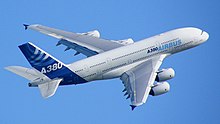
Two of the original core objectives of the European Economic Community were the development of a common market, subsequently renamed the single market, and a customs union between its member states. The single market involves the free circulation of goods, capital, people and services within the EU,[129] and the customs union involves the application of a common external tariff on all goods entering the market. Once goods have been admitted into the market they cannot be subjected to customs duties, discriminatory taxes or import quotas, as they travel internally. The non-EU member states of Iceland, Norway, Liechtenstein and Switzerland[53] Half the trade in the EU is covered by legislation harmonised by the EU.[143] participate in the single market but not in the customs union.
Free movement of capital is intended to permit movement of investments such as property purchases and buying of shares between countries.[144] Until the drive towards Economic and Monetary Union the development of the capital provisions had been slow. Post-Maastricht there has been a rapidly developing corpus of ECJ judgements regarding this initially neglected freedom. The free movement of capital is unique insofar as it is granted equally to non-member states.
The free movement of persons means that EU citizens can move freely between member states to live, work, study or retire in another country. This required the lowering of administrative formalities and recognition of professional qualifications of other states.[145]
The free movement of services and of establishment allows self-employed persons to move between member states in order to provide services on a temporary or permanent basis. While services account for 60–70% of GDP, legislation in the area is not as developed as in other areas. This lacuna has been addressed by the recently passed Directive on services in the internal market which aims to liberalise the cross border provision of services.[146] According to the Treaty the provision of services is a residual freedom that only applies if no other freedom is being exercised.
Monetary union
The creation of a European single currency became an official objective of the European Economic Community in 1969. However, it was only with the advent of the Maastricht Treatymonetary union no later than 1 January 1999. On this date the euro was duly launched by eleven of the then fifteen member states of the EU. It remained an accounting currency until 1 January 2002, when euro notes and coins were issued and national currencies began to phase out in the eurozone, which by then consisted of twelve member states. The eurozone has since grown to seventeen countries, the most recent being Estonia which joined on 1 January 2011. in 1993 that member states were legally bound to start the
All other EU member states, except Denmark and the United Kingdom, are legally bound to join the euro[147] when the convergence criteria are met, however only a few countries have set target dates for accession. Sweden has circumvented the requirement to join the euro by not meeting the membership criteria.[nb 16]
The euro is designed to help build a single market by, for example: easing travel of citizens and goods, eliminating exchange rate problems, providing price transparency, creating a single financial market, price stability and low interest rates, and providing a currency used internationally and protected against shocks by the large amount of internal trade within the eurozone. It is also intended as a political symbol of integration and stimulus for more.[148] Since its launch the euro has become the second reserve currency in the world with a quarter of foreign exchanges reserves being in euro.[149] The euro, and the monetary policies of those who have adopted it in agreement with the EU, are under the control of the European Central Bank[150] (ECB).
The European Central Bank (ECB) is the central bank for the eurozone (consisting of the EU member states which have adopted the euro), and thus controls monetary policy in that area with an agenda to maintain price stability. It is at the centre of the European System of Central Banks, which comprehends all EU national banks, and is guided by a board comprising of the President of the European Central Bank, who is appointed by the European Council, and national bank governors.[151]
Competition
The EU operates a competition policy intended to ensure undistorted competition within the single market.[nb 17] The Commission as the competition regulator for the single market is responsible for antitrust issues, approving mergers, breaking up cartels, working for economic liberalisation and preventing state aid.[152]
The Competition Commissioner, currently Joaquín Almunia, is one of the most powerful positions in the Commission, notable for the ability to affect the commercial interests of trans-national corporations.[153] For example, in 2001 the Commission for the first time prevented a merger between two companies based in the United States (GE and Honeywell) which had already been approved by their national authority.[154] Another high profile case against Microsoft, resulted in the Commission fining Microsoft over €777 million following nine years of legal action.[155]
Agriculture
The Common Agricultural Policy (CAP) is one of the oldest policies of the European Community, and was one of its core aims.[156] The policy has the objectives of increasing agricultural production, providing certainty in food supplies, ensuring a high quality of life for farmers, stabilising markets, and ensuring reasonable prices for consumers.[nb 18] It was, until recently, operated by a system of subsidies and market intervention. Until the 1990s, the policy accounted for over 60% of the then European Community's annual budget, and still accounts for around 35%.[156]
The policy's price controls and market interventions led to considerable overproduction, resulting in so-called butter mountains and wine lakes. These were intervention stores of produce bought up by the Community to maintain minimum price levels. In order to dispose of surplus stores, they were often sold on the world market at prices considerably below Community guaranteed prices, or farmers were offered subsidies (amounting to the difference between the Community and world prices) to export their produce outside the Community. This system has been criticised for under-cutting farmers outside of Europe, especially those in the developing world.[157]
The overproduction has also been criticised for encouraging environmentally unfriendly intensive farming methods.[157] Supporters of CAP say that the economic support which it gives to farmers provides them with a reasonable standard of living, in what would otherwise be an economically unviable way of life. However, the EU's small farmers receive only 8% of CAP's available subsidies.[157]
Since the beginning of the 1990s, the CAP has been subject to a series of reforms. Initially these reforms included the introduction of set-aside in 1988, where a proportion of farm land was deliberately withdrawn from production, milk quotas (by the McSharry reforms in 1992) and, more recently, the 'de-coupling' (or disassociation) of the money farmers receive from the EU and the amount they produce (by the Fischler reforms in 2004). Agriculture expenditure will move away from subsidy payments linked to specific produce, toward direct payments based on farm size. This is intended to allow the market to dictate production levels, while maintaining agricultural income levels.[156] One of these reforms entailed the abolition of the EU's sugar regime, which previously divided the sugar market between member states and certain African-Caribbean nations with a privileged relationship with the EU.[158]
Energy
| EU energy production | |
|---|---|
| 46% of total EU primary energy use | |
| Nuclear energy[nb 19] | 29.3% |
| Coal & lignite | 21.9% |
| Gas | 19.4% |
| Renewable energy | 14.6% |
| Oil | 13.4% |
| Other | 1.4% |
| Net imports of energy | |
| 54% of total primary EU energy use | |
| Oil & petroleum products | 60.2% |
| Gas | 26.4% |
| Other | 13.4% |
In 2006, the 27 member states of the EU had a gross inland energy consumption of 1,825 million tonnes of oil equivalent (toe).[159] Around 46% of the energy consumed was produced within the member states while 54% was imported.[159] In these statistics, nuclear energy is treated as primary energy produced in the EU, regardless of the source of the uranium, of which less than 3% is produced in the EU.[160]
The EU has had legislative power in the area of energy policy for most of its existence; this has its roots in the original European Coal and Steel Community. The introduction of a mandatory and comprehensive European energy policy was approved at the meeting of the European Council in October 2005, and the first draft policy was published in January 2007.[161]
The EU currently imports 82% of its oil, 57% of its gas[162] and 97.48% of its uranium[160]Europe's dependence on Russian energy is endangering the Union and its member countries. The EU is attempting to diversify its energy supply.[163] demands. There are concerns that
Infrastructure
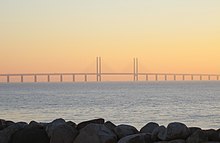
The EU is working to improve cross-border infrastructure within the EU, for example through the Trans-European Networks (TEN). Projects under TEN include the Channel Tunnel, LGV Est, the Fréjus Rail Tunnel, the Öresund Bridge, the Brenner Base Tunnel and the Strait of Messina Bridge. In 2001 it was estimated that by 2010 the network would cover: 75,200 kilometres (46,700 mi) of roads; 78,000 kilometres (48,000 mi) of railways; 330 airports; 270 maritime harbours; and 210 internal harbours.[164][165]
The developing European transport policies will increase the pressure on the environment in many regions by the increased transport network. In the pre-2004 EU members, the major problem in transport deals with congestion and pollution. After the recent enlargement, the new states that joined since 2004 added the problem of solving accessibility to the transport agenda.[166] The Polish road network in particular was in poor condition: at Poland's accession to the EU, 4,600 roads needed to be upgraded to EU standards, demanding approximately €17 billion.[167]
The Galileo positioning system is another EU infrastructure project . Galileo is a proposed Global Navigation Satellite System, to be built by the EU and launched by the European Space AgencyGlobal Positioning System, but also to give more complete global coverage and allow for far greater accuracy, given the aged nature of the GPS system.[168][169] (ESA), and is to be operational by 2010. The Galileo project was launched partly to reduce the EU's dependency on the US-operated It has been criticised by some due to costs, delays, and their perception of redundancy given the existence of the GPS system.
Education and science
Education and science are areas where the EU's role is limited to supporting national governments. In education, the policy was mainly developed in the 1980s in programmes supporting exchanges and mobility. The most visible of these has been the Erasmus Programme, a university exchange programme which began in 1987. In its first 20 years it has supported international exchange opportunities for well over 1.5 million university and college students and has become a symbol of European student life.[170]
There are now similar programmes for school pupils and teachers, for trainees in vocational education and training, and for adult learners in the Lifelong Learning Programme 2007–2013. These programmes are designed to encourage a wider knowledge of other countries and to spread good practices in the education and training fields across the EU.[171] Through its support of the Bologna process the EU is supporting comparable standards and compatible degrees across Europe.
Scientific development is facilitated through the EU's Framework Programmes, the first of which started in 1984. The aims of EU policy in this area are to co-ordinate and stimulate research. The independent European Research Council allocates EU funds to European or national research projects.[172] The Seventh Framework Programme (FP7) deals in a number of areas, for example energy where it aims to develop a diverse mix of renewable energy for the environment and to reduce dependence on imported fuels.[173]
[edit] Demographics
The combined population of all 27 member states has been forecast in October, 23rd 2010 at 501,064,211 as of 1 January 2010.[5] The EU's population is 7.3% of the world total, yet the EU covers just 3% of the Earth's land, amounting to a population density of 115,9 per km² (300,1 per sq mi) making the EU one of the most densely populated regions of the world.
[edit] Urbanization
City | City limits
(2006)  | Density
/km²  | Density
/sq mi  | Urban area
(2005)  | LUZ
(2004)  |
|---|---|---|---|---|---|
| London | 7,512,400 | 4,761 | 12,330 | 9,332,000 | 11,917,000 |
| Berlin | 3,410,000 | 3,815 | 9,880 | 3,761,000 | 4,971,331 |
| Madrid | 3,228,359 | 5,198 | 13,460 | 4,990,000 | 5,804,829 |
| Paris | 2,153,600 | 24,672 | 63,900 | 9,928,000 | 11,089,124 |
| Rome | 2,708,395 | 2,105 | 5,450 | 2,867,000 | 3,457,690 |
The EU is home to more global cities than any other region in the world.[175] It contains 16 cities with populations of over one million, the largest being London.
Besides many large cities, the EU also includes several densely populated regions that have no single core but have emerged from the connection of several cites and now encompass large metropolitan areas. The largest are Rhine-Ruhr having approximately 11.5 million inhabitants (Cologne, Dortmund, DüsseldorfRandstad approx. 7 million (Amsterdam, Rotterdam, The Hague, Utrecht et al.), Frankfurt/Rhine-Main approx. 5.8 million (Frankfurt, Wiesbaden et al.), the Flemish diamondAntwerp, Brussels, Leuven and Ghent), the Öresund Region approx. 3.7 million (Copenhagen, Denmark and Malmö, Sweden), and the Upper Silesian Industrial Region approx. 3.5 million (Katowice, Sosnowiec et al.)[176] et al.), approx. 5.5 million (urban area in between
Language | Native Speakers | Total |
|---|---|---|
| English | 13% | 51% |
| German | 18% | 32% |
| French | 12% | 26% |
| Italian | 13% | 16% |
| Spanish | 9% | 15% |
| Polish | 9% | 10% |
| Dutch | 5% | 6% |
| Greek | 3% | 3% |
| Czech | 2% | 3% |
| Swedish | 2% | 3% |
| Hungarian | 2% | 2% |
| Portuguese | 2% | 2% |
| Slovak | 1% | 2% |
| Danish | 1% | 1% |
| Finnish | 1% | 1% |
| Lithuanian | 1% | 1% |
| Slovenian | 1% | 1% |
| Estonian | <1% | <1% |
| Irish/Gaelic | <1% | <1% |
| Latvian | <1% | <1% |
| Maltese | <1% | <1% |
| 1Published in 2006, before the
| ||
Languages
Among the many languages and dialects used in the EU, it has 23 official and working languages: Bulgarian, Czech, Danish, Dutch, English, Estonian, Finnish, French, German, Greek, Hungarian, Italian, Irish, Latvian, Lithuanian, Maltese, Polish, Portuguese, Romanian, Slovak, Slovene, Spanish, and Swedish.[179][180] Important documents, such as legislation, are translated into every official language. The European Parliament provides translation into all languages for documents and its plenary sessions.[181] Some institutions use only a handful of languages as internal working languages.[182]Language policy is the responsibility of member states, but EU institutions promote the learning of other languages.[nb 20][183]
German is the most widely spoken mother tongue (about 88.7 million people as of 2006), followed by English, Italian, and French. English is by far the most spoken foreign language and is spoken in over half (51%) of the EU population (including native English speakers), with German and French following. 56% of EU citizens are able to engage in a conversation in a language other than their mother tongue.[184] Most official languages of the EU belong to the Indo-European language family, except Estonian, Finnish, and Hungarian, which belong to the Uralic language family, and Maltese, which is an Afroasiatic language. Most EU official languages are written in the Latin alphabet except Bulgarian, written in Cyrillic, and Greek, written in the Greek alphabet.[185]
Besides the 23 official languages, there are about 150 regionalminority languages, spoken by up to 50 million people.[185]Catalan/Valencian, Galician, and the non-Indo-European Basque), Scottish Gaelic, and Welsh[186] can be used by citizens in communication with the main European institutions.[187] Although EU programmes can support regional and minority languages, the protection of linguistic rights is a matter for the individual member states. The European Charter for Regional or Minority Languages ratified by most EU states provides general guidelines that states can follow to protect their linguistic heritage. and Of these, only the Spanish regional languages (i.e.,
Religion
The EU is a secular body with no formal connection with any religion, but Article 17 of the Treaty on the Functioning of the European Union recognises the "status under national law of churches and religious associations" as well as that of "philosophical and non-confessional organisations".[188]

The preamble to the Treaty on European Union mentions the "cultural, religious and humanist inheritance of Europe".[188] Discussion over the draft texts of the European Constitution and later the Treaty of Lisbon included proposals to mention Christianity or "God" or both, in the preamble of the text, but the idea faced opposition and was dropped.[190]
Christians in the EU are divided among followers of Roman Catholicism, numerous Protestantnorthern Europe), and Eastern Orthodox and Eastern Catholic (in south eastern Europe). Other religions, such as Islam and Judaism, are also represented in the EU population. As of 2009, the EU had an estimated Muslim population of 13 million,[191] and an estimated Jewish population of over a million.[192] denominations (especially in
Eurostat's Eurobarometer opinion polls showed in 2005 that 52% of EU citizens believed in a god, 27% in "some sort of spirit or life force", and 18% had no form of belief.[189] Many countries have experienced falling church attendance and membership in recent years.[193] The countries where the fewest people reported a religious belief were Estonia (16%) and the Czech Republic (19%).[189] The most religious countries are Malta (95%; predominantly Roman Catholic), and Cyprus and Romania both with about 90% of the citizens believing in God (both predominantly Eastern Orthodox). Across the EU, belief was higher among women, increased with age, those with religious upbringing, those who left school at 15 with a basic education, and those "positioning themselves on the right of the political scale (57%)."[189]
Culture
Cultural co-operation between member states has been a concern of the EU since its inclusion as a community competency in the Maastricht Treaty.[194] Actions taken in the cultural area by the EU include the Culture 2000 7-year programme,[194] the European Cultural Month[195] the Media Plus programme,[196] orchestras such as the European Union Youth Orchestra[197] and the European Capital of Culture programme – where one or more cities in the EU are selected for one year to assist the cultural development of that city.[198] event,
Sport is mainly the responsibility of an individual member states or other international organisations rather than that of the EU. However, there are some EU policies that have had an impact on sport, such as the free movement of workers which was at the core of the Bosman ruling, which prohibited national football leagues from imposing quotas on foreign players with European citizenship.[199] The Treaty of Lisbon requires any application of economic rules to take into account the specific nature of sport and its structures based on voluntary activity.[200]International Olympic CommitteeFIFA, due to objections over the applications of free market principles to sport which led to an increasing gap between rich and poor clubs.[201] This followed lobbying by governing organisations such as the and




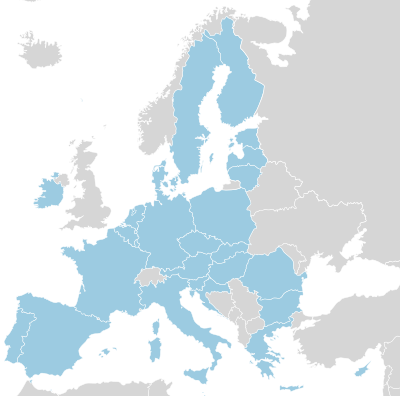
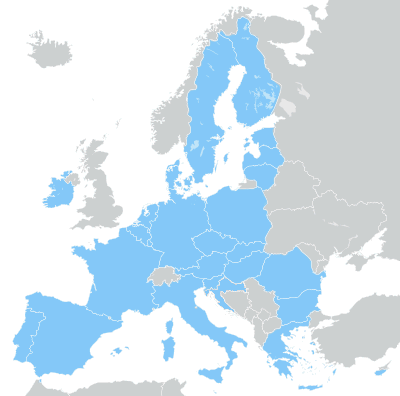







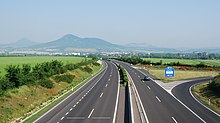
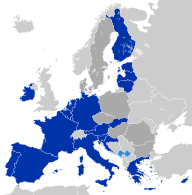
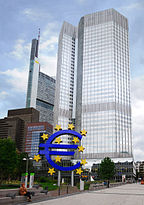





Ei kommentteja:
Lähetä kommentti